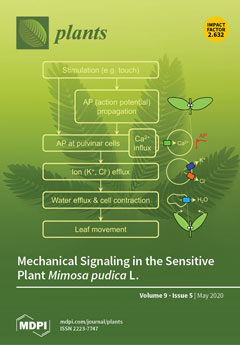Attempts to identify crop genetic material with larger growth stimulation at projected elevated atmospheric CO
2 concentrations are becoming more common. The probability of reductions in photosynthesis and yield caused by short-term variation in CO
2 concentration within elevated CO
2 treatments in
[...] Read more.
Attempts to identify crop genetic material with larger growth stimulation at projected elevated atmospheric CO
2 concentrations are becoming more common. The probability of reductions in photosynthesis and yield caused by short-term variation in CO
2 concentration within elevated CO
2 treatments in the free-air CO
2 enrichment plots raises the question of whether similar effects occur in glasshouse or indoor chamber experiments. These experiments were designed to test whether even the normal, modest, cyclic variation in CO
2 concentration typical of indoor exposure systems have persistent impacts on photosynthesis and growth, and to explore mechanisms underlying the responses observed. Wheat, cotton, soybeans, and rice were grown from seed in indoor chambers at a mean CO
2 concentration of 560 μmol mol
−1, with “triangular” cyclic variation with standard deviations of either 4.5 or 18.0 μmol mol
−1 measured with 0.1 s sampling periods with an open path analyzer. Photosynthesis, stomatal conductance, and above ground biomass at 20 to 23 days were reduced in all four species by the larger variation in CO
2 concentration. Tests of rates of stomatal opening and closing with step changes in light and CO
2, and tests of responses to square-wave cycling of CO
2 were also conducted on individual leaves of these and three other species, using a leaf gas exchange system. Reduced stomatal conductance due to larger amplitude cycling of CO
2 during growth occurred even in soybeans and rice, which had equal rates of opening and closing in response to step changes in CO
2. The gas exchange results further indicated that reduced mean stomatal conductance was not the only cause of reduced photosynthesis in variable CO
2 conditions.
Full article






